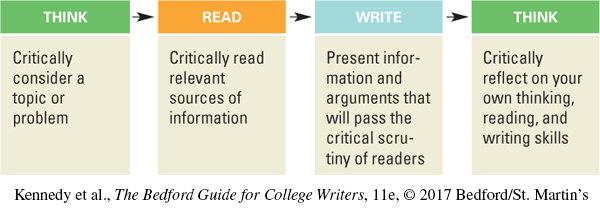A Process of Critical Thinking
For more on critical reading, see Ch. 2.
Critical thinking, like critical reading, draws on a cluster of intellectual strategies and skills.
| CriticalThinking Skill | Definition | Applicationsfor Readers | Applicationsfor Writers |
| Analysis | Breaking down information into its parts and elements | Analyzing the information in articles, reports, and books to grasp the facts and concepts they contain | Analyzing events, ideas, processes, and structures to understand them and explain them to readers |
| Synthesis | Putting together elements and parts to form new wholes | Synthesizing information from several sources, examining implications, and drawing conclusions supported by reliable evidence | Synthesizing source materials with your own thoughts in order to convey the unique combination to others |
| Evaluation | Judging according to standards or criteria | Evaluating a reading by determining standards for judging, applying them to the reading, and arriving at a conclusion about its value, significance, or credibility | Evaluating something in writing by convincing readers that your standards are reasonable and that the subject either does or does not meet those standards |
36
These three activities—analysis, synthesis, and evaluation—are the core of critical thinking. They are not new to you, but applying them rigorously in college-level reading and writing may be. When you approach college reading and writing tasks, instructors will expect you (and you should expect yourself) to think, read, write, and think some more.

Getting Started
You use critical thinking every day to explore problems step by step and reach solutions. Suppose you don’t have enough money both to pay your tuition and to buy the car you need. First, you might pin down the causes of your financial problem. Next, you might examine your options to find the best solution, as shown in the graphic below.
You can follow the same steps to examine many types of issues, helping you analyze a situation or dilemma, creatively synthesize to develop alternatives, and evaluate a possible course of action.
Learning by Doing Thinking Critically to Explore an Issue
Learning by Doing Thinking Critically to Explore an Issue
Thinking Critically to Explore an Issue
You’ve worked hard on a group presentation that will be a major part of your grade—and each member of the group will get the same grade. Two days before the project is due, you discover that one group member has plagiarized heavily from sources well known to your instructor. Working together with classmates, use critical thinking to explore your problem and determine what you might do.
Applying Critical Thinking to Academic Problems
It is important to support critical thinking with evidence. For advice on selecting and testing evidence, see Learning by Writing in Ch. 9.
As you grapple with academic problems and papers, you’ll be expected to use your critical thinking skills—analyzing, synthesizing, and evaluating—as you read and write. You may simply dive in, using each skill as needed. However, the very wording of an assignment or examination question may alert you to a skill that your instructor expects you to use, as the first sample assignment in each set illustrates in the chart Using Critical Thinking for College Assignments.
37
